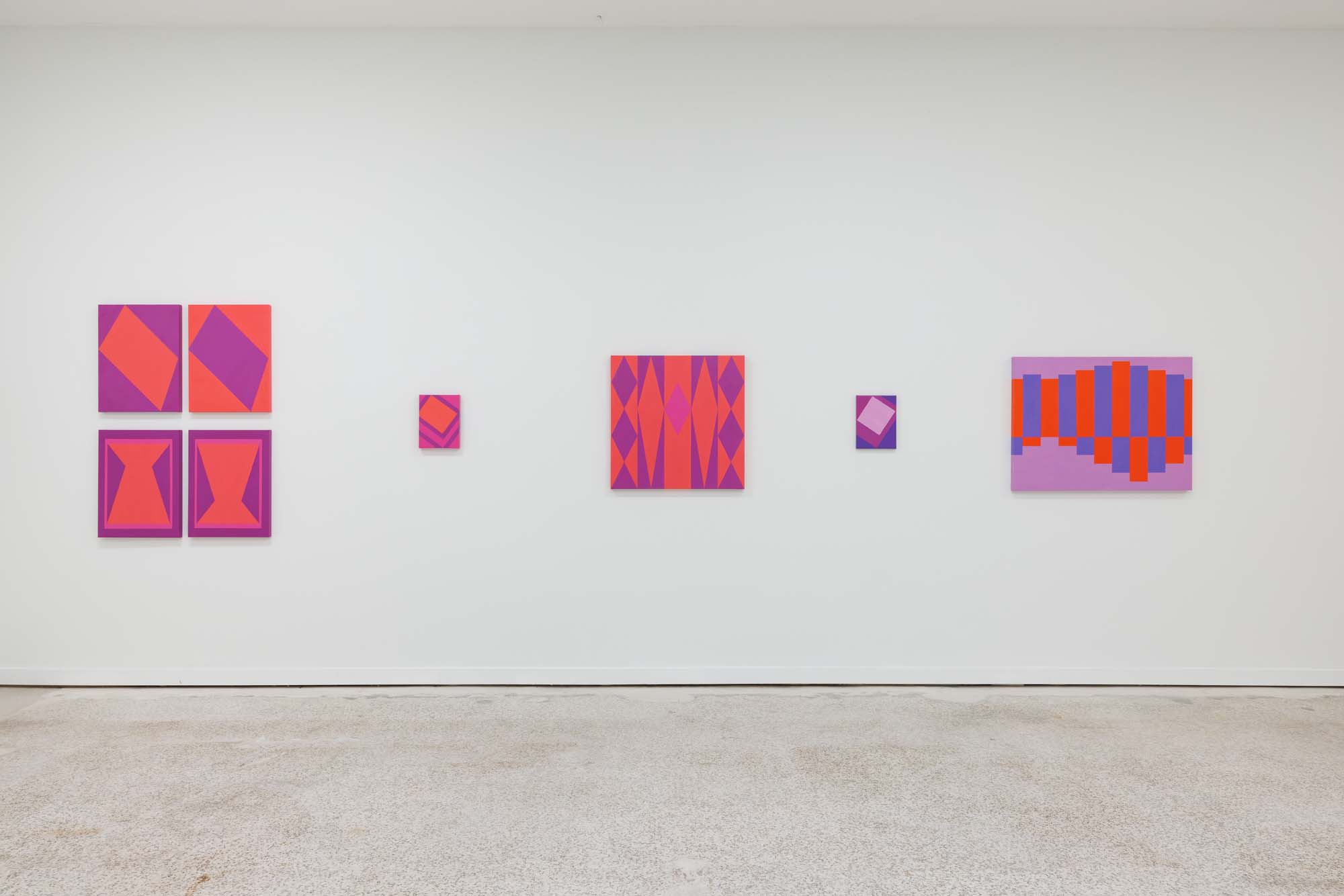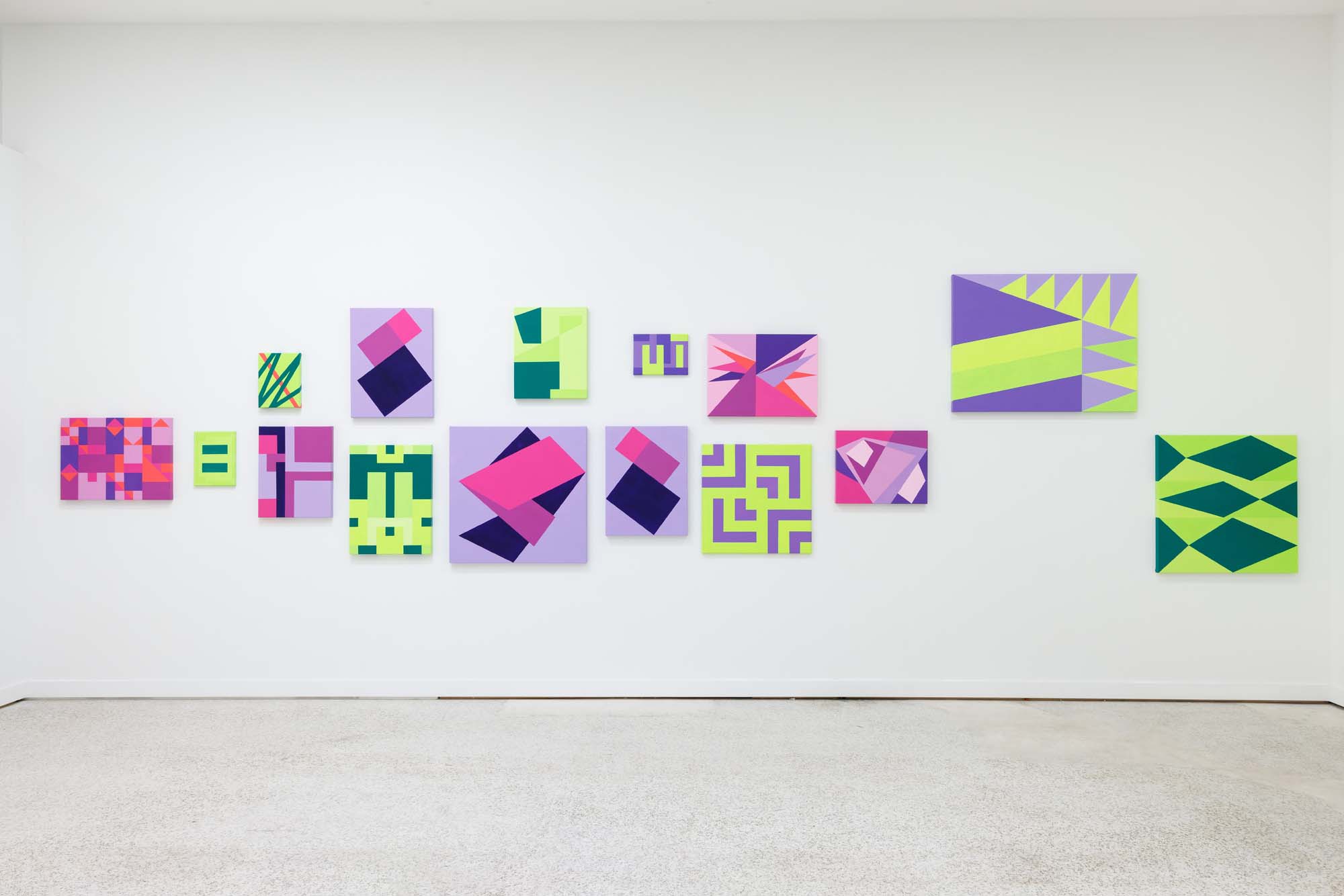
Karen Rifas explores the ways we inhabit, interpret and intuit space. Her approach has range: from sculptural installations of cords and dried leaves to mural-sized geometric abstractions. Originally from Chicago, the artist moved to Miami 70 years ago and has witnessed extraordinary changes in the city’s built environment.
By the time I met her in the 2010s, Rifas was already renowned for her stitched leaf and cord installations seen in numerous exhibitions, and private and public collections.
She transitioned into a new body of work that stripped her designs down to the lines beneath them. From there she defined the space between the lines with color.
Our first time working together was during her installation at meetinghouse in downtown Miami, where she painted patterns on the walls to accentuate and alter one’s experience of the penthouse’s interior. Over the past eight years, geometric forms in vibrant colors have become a defining element of her practice, as seen in a transformative show at the Bass Museum of Art in 2018 and in several permanent installations and projects for Miami Dade Art in Public Places. Her 2020 show at Emerson Dorsch was incandescent, transforming the gallery into a jewelbox of dancing geometric forms and radiant color.
Patricia Ortega Miranda, an independent art historian based in Baltimore, Maryland, curated a survey of Karen Rifas’s career in 2022. Miranda identified connections between seemingly distinct bodies of work, from a plexiglass “wunderkabinett” to a platform that staged various setups of brightly painted blocks.
Rifas’s new series of paintings, titled Miami to Maine, are meditations made amidst her life in Miami and during time spent in Maine. On an extended trip to Brunswick, Maine, her
process was to draw and make studies every morning. With each session, she traversed the two-dimensional plane with a line and answered it with another. She began with a plan and resolved the problem with play and improvisation. In addressing the plane, she made space. This quiet process accumulates impact with iterations.
The Miami to Maine project was initiated with support from the Miami Individual Artist Grant, which Rifas received in 2023 and 2024. During her time in Maine, she explored and photo-documented coastal and mountainous areas, spent time at a century-old lakefront cabin in the woods, and later returned to Miami to reflect on her experiences, revisit her documentation, and bring this new body of work to life.
For the exhibition, the installation of these small to medium-sized paintings begins with a marked focus on the horizon and ways of addressing it. These abstracted landscapes and their quiet palette coincide with Rifas’s time in Maine. In the next room, the meditative mood gives way to bold energy, marked by vibrant colors and an abstraction rarely approaching representation. There is an interplay between prismatic and geometric or pixelated abstraction, as if the pace of life in Miami leaves no time or space for vistas, only essences.
There is a crescendo and building tempo as the painting’s installation resolves, as we come to a small painting that seems to contain a computer chip’s worth of memories.

Karen Rifas (Chicago, b. 1942) has shown nationally and internationally since the 1980s. She is the second recipient of The Michael Richards Award, presented by Oolite Arts. This award is given to Miami-based artists who have created a recognized body of original, high-quality work over a sustained period of time and who, through their practice, achieve the highest levels of professional distinction in the visual arts. Her work is represented in many public and private collections, including Museo de Arte de Ponce in Puerto Rico, The Bass Museum, Fairchild Tropical Gardens, Oolite Arts, FIU Frost Art Museum, NSU Art Museum, Fort Lauderdale, FL, Museum of Contemporary Art North Miami, Miami-Dade Art in Public Places Trust, and Perez Art Museum Miami.
Emerson Dorsch is a contemporary art gallery with two complementary roles: to represent a core group of select South Florida-based artists, to host and represent excellent emerging and mid-career visiting artists. The gallery’s name reflects the partnership in art and life between the husband and wife team Brook Dorsch and Tyler Emerson-Dorsch. We believe in the joys of an artful life, of experiencing art close to the source. Through all the gallery’s activities, we foster art patronage and artistic community.
Brook Dorsch founded Dorsch Gallery in the early 1990s to exhibit Miami-based artists. Tyler Emerson-Dorsch joined the gallery in 2008 after earning a Masters from the Center for Curatorial Studies at Bard College. After almost 25 years, the gallery moved a second time to Little Haiti, a neighborhood northwest of downtown Miami.

Open to all visitors from 11—4 pm. Progressive Art Brunch brings together participating galleries several Sundays throughout the year. The event highlights the current programming at each venue and enables visitors a more intimate look at the exhibitions on view.
Sign-up for our mailing list.
